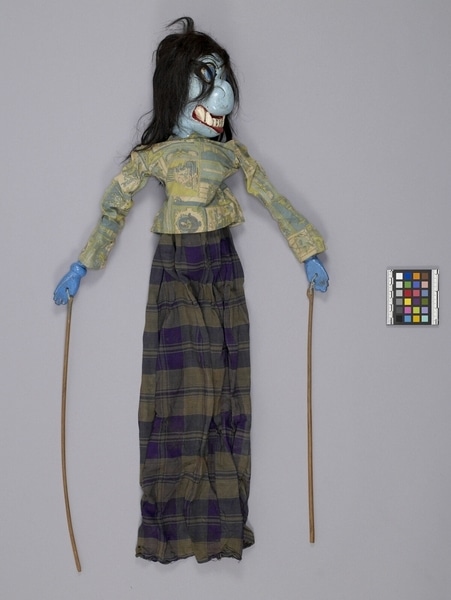Rod Puppet Item Number: Ib352 a-c from the MOA: University of British Columbia


Description
Three-dimensional humanoid puppet: the large head (part b) fits into a body clothed in a green patterned shirt and purple and green plaid skirt (part a), and a control rod (part c) with a long shaft that passes through the body and fits into the neck of the figure's head. The body has jointed arms, each with a long controlling rod attached. The figure has a blue face, neck and hands. The figure has light blue bulging eyes and a large bulbous nose. Lower tooth row is visible; upper and lower fangs present at each corner of mouth, between red lips. Human hair nailed in small bunches to head; bump at base of skull at rear. Torso unpainted under shirt; upper arms made of twisted cloth rope, lower arms and simple outstretched hands of wood. Head movement controlled by removable rod extending though body to handle beneath skirt.
History Of Use
Javanese puppetry as an art form probably developed by the 11th century. The three-dimensional wooden wayang golek puppets of western Java appeared during the 16th century. Originally the plays depicted Javanese mythology, but after the Indian conquest of Java the Hindu epics, Ramayana and Mahabharata, were incorporated into the cycles, which comprise about 200 plays. An individual or group hires a dalang (puppet-master) to celebrate important occasions. The performances often last all night and are generally presented in three acts, with vocal and instrumental accompaniment. The individual plays vary widely in detail but usually involve conflict between good and evil. They serve a moral and religious purpose, and more recently, one of political commentary. Each puppet's character is represented by its appearance and placement onstage; protagonists with strong elements of good are placed to the right, antagonists of violent or evil nature to the left. Buta Hijau is a miscellaneous ogre, one of a horde, who may appear in almost any play. Ogres are considered foreigners, although they are an indigenous Javanese addition to the Hindu epics upon which the plays are based. They appear to the left of the stage, generally in scenes depicting foreign lands or in battle as the allies of evil groups more directly involved.
Cultural Context
Theatrical performance.
Iconographic Meaning
The blue face and hands identify the puppet as Buta Hijau, or Ogre. Large, coarse features are typical of ogres (rakshasa), particularly fangs, nose, bulge on rear neck, and blue eyes. He displays no fine features; the posture of his hands, exaggerated facial features, and unkempt hair demonstrate his low rank and lack of refinement. Also a character from the Ramayana.
Item History
- Made in Java, Indonesia
- Owned by Tradewind Antiques before March 15, 1983
- Received from Museum of Anthropology Shop Volunteers (Funding source) and Tradewind Antiques (Seller) on March 15, 1983
What
- Name
- Rod Puppet
- Identification Number
- Ib352 a-c
- Type of Item
- puppet
- Material
- wood, cotton fibre, paint, human hair and metal
- Manufacturing Technique
- carved, painted, sewn and nailed
- Part A
- height 65.5 cm, width 20.0 cm, depth 10.0 cm
- Part B
- height 20.5 cm, width 10.0 cm, depth 12.0 cm
- Part C
- height 39.5 cm, width 2.3 cm, depth 0.8 cm
Who
- Culture
- Sundanese
- Previous Owner
- Tradewind Antiques
- Received from
- Museum of Anthropology Shop Volunteers (Funding source) and Tradewind Antiques (Seller)
Where
- Holding Institution
- MOA: University of British Columbia
- Made in
- Java, Indonesia
When
- Ownership Date
- before March 15, 1983
- Acquisition Date
- on March 15, 1983
Other
- Condition
- fair
- Accession Number
- 0886/0086 a-c